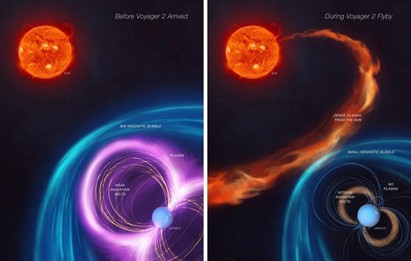PREVIOUS
Mystifying Magnetic Field of Uranus
November 18 , 2024
17 hrs 0 min
18
0
- NASA’s robotic spacecraft Voyager 2 conducted a five-day flyby over Uranus in 1986.
- The Voyager 2 observations left a misimpression about the magnetosphere of Uranus.
- During the fly, it is lacking in plasma and possessing uncommonly intense belts of highly energetic electrons.
- The probe visited at a time of unusual conditions - an intense solar wind event - that led to misleading observations about Uranus, and specifically its magnetic field.
- So, this event compressed Uranus’s magnetosphere during the observation.
- The absence of plasma had previously led scientists to believe the moons were dormant.
- But the new findings suggested that the Uranus’s five major moons may not be geologically inactive.
- Magnetosphere is a region of space surrounding a planet where the planet’s magnetic field dominates.
- It is creating a protective zone against solar and cosmic particle radiation.
- Uranus is big enough to fit 63 Earths inside it.
- It orbits almost 20 times further from the sun than Earth does and has 28 known moons and two sets of rings.

Leave a Reply
Your Comment is awaiting moderation.


